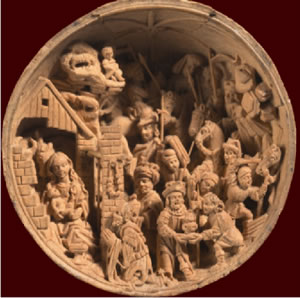The Rijksmuseum will celebrate Christmas 2010 with two exceptional acquisitions that highlight the birth of Christ. It recently acquired an extremely rare silver ‘prayer nut’, containing miniature carvings only millimetres in size and depicting the birth of Christ and the Adoration of the Magi.
 A prayer nut was an extravagant devotional object from the late Middle Ages: two silver-plated pieces of carved wood with a diameter of 4.8cm joined together to form a round ‘nut’. At the same time, the Rijksmuseum will exhibit the masterfully carved Heilige Familie (Holy Family); a small sculpture created by Jan III van Doorne that dates back to c. 1650.
A prayer nut was an extravagant devotional object from the late Middle Ages: two silver-plated pieces of carved wood with a diameter of 4.8cm joined together to form a round ‘nut’. At the same time, the Rijksmuseum will exhibit the masterfully carved Heilige Familie (Holy Family); a small sculpture created by Jan III van Doorne that dates back to c. 1650.
The small round ball called a ‘prayer nut’ was carried around by the wealthy on a silver chain. The nut was not used exclusively for prayer, but was also displayed as a status symbol and admired for the extremely detailed carvings found inside. The newly acquired prayer nut is one of the most beautiful examples of miniature carving known. One half depicts the birth of Christ, the other the Adoration of the Magi – down to the square millimetre, literally. The carving is silver-plated, making it one of the finest examples of secular Gothic silver from the Low Countries.
The nut, dating from around 1510-1520, comes from the estate of an old Dutch family and was probably owned by the author Johannes Kneppelhout (1814-1885, also known in Dutch as ‘Klikspaan’) and was rescued from the ‘De Hemelsche Berg’ estate near Oosterbeek in 1944 during the Battle of Arnhem.
Frits Scholten, curator of sculpture at the Rijksmuseum says, ‘We are delighted with the acquisition of this exquisite, small object. This prayer nut is the only one in the world to have been received with its original silver-plating intact. In the 16th century, it was a true status symbol, comparable to the most expensive Patek Philippe watches of today.’
The masterfully carved, small sculpture Heilige Familie has a playful character. The glass inlaid eyes of the three figures are truly exceptional. Given its intimate, informal character, the sculpture strikes a balance between its roles as a pure work of religious art for personal Catholic devotion and as an example of a genre of informal sculpture. The sculpture is signed ‘IVD’ by the sculptor-carver Jan van Doorne of Mechelen. Few other works by Van Doorne are known.
The prayer nut and the Heilige Familie will be exhibited at the Rijksmuseum (on the Rotterdam staircase) from 14 December to 7 February.
The acquisition of the prayer nut was made possible in part by the Ebus Fonds, which is a named fund of the Rijksmuseum. The Ebus Fonds supports the Rijksmuseum in the development of its collection of medieval art. Without its named funds, the Rijksmuseum would be unable to finance many of its acquisitions.
Image: Prayer nut, silver and boxwood, c. 1510-1520, one of the two hemispheres.
www.rijksmuseum.nl



